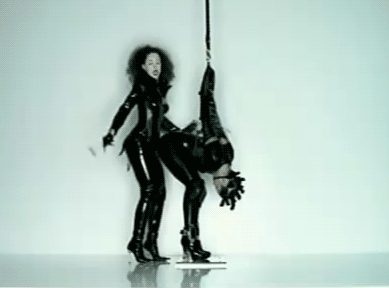www.bustle.com
When I was a teenager, I had an older relative who used to like to tell any young person who crossed her path, "You kids think you invented sex!" And while I didn't technically think that sex had been invented in 1997 (the year I finally got someone to agree to touch my vagina), I did assume that all of the fun and interesting kinds of sex had probably been invented fairly recently (probably by people at Woodstock or something). After all, hadn't sex been pretty much limited to heterosexual missionary-style couplings with the lights off until, like, 1963?
Of course, after I took a break from having my vagina touched and decided to go read some cultural history, I learned that sexual innovation was nothing new — not only had people been inventing and then dropping sexual trendssince pretty much the beginning of recorded history, but many of our most hallowed sexual and romantic traditions started as a freaky sexual trend hundreds or thousands of years ago (or, conversely, some things that we currently consider a freaky sexual trend where considered totally vanilla and normal hundreds of years ago).
So what did our ancient ancestors do when they were looking to spice things up on date night? Here are seven historical sex trends that will leave you unable to look your history textbook in the eye ever again.
Ancient Egypt (3100-332 BC): Lipstick Means You're Open To Oral
Oral sex was practiced in most ancient societies because, duh, oral sex is fun. But ancient Egyptian society is often noted as the olden society most enamored with going down — so much so that one of the most important myths of Egyptian culture centers around a blowjob given to a clay penis, which brings the god Osiris back to life (why do they refuse to teach you anything useful like this in school?).
The ancient Egyptian enthusiasm for oral sex is credited by some historians with creating another cornerstone of modern society: lipstick. Egyptians are often thought to have been the first culture to wear makeup; under this theory, the Egyptian enthusiasms for make up and oral sex collided when ancient Egyptian courtesans publicized their oral sex prowess by coloring their lips — a practice that eventually evolved into our modern red lip classic thing that you like.
Modern Equivalent: Those sex-related jelly bracelets from that episode ofDegrassi.
Ancient Rome (753 BC- 476 AD): Deter Impotence By Avoiding Lettuce
A belief in aphrodisiac foods was common in a lot of ancient cultures, including ancient Rome. And since you can't believe that some foods get you horny without believing that other foods keep you from getting horny, the ancient Romans believed that other foods possessed anti-aphrodisiac qualities — particularly lettuce. Ancient Roman men were suspicious of lettuce, which they believed could instantly render a man impotent. So Roman males tended to avoid the green stuff — which I can only assume led to a lack of fiber in their diet.
Modern Equivalent: Believing that certain sodas damage your sperm count.
Middle Ages Europe (400-1400): Fall In Love From Afar
The Middle Ages were not such a great time for banging. The Church had very restrictive rules about who you could bang and when you could get down to it. And if you went against one of these rules — by doing anything from having gay sex to having sex with your spouse on Sunday — you could be severely punished, sometimes with death.
Of course, you can't stop people from banging, even if you make crazy rules about it, and so people in the Middle Ages kept on banging. But the restrictions on sex — as well as changing ideas about things like whether marriages should be arranged by families or voluntary — led to the creation of a concept called "courtly love" in the late 11th century.
Courtly love existed exclusively between two people who were not married to each other, but probably were married to other people. Typically, the female member of the courtly love couple was a noblewoman in a marriage set up by her family; her male courtly lover may have been a troubador, knight, or other man of the courtier class. The male courtly lover put his feelings for the female courtly lover into songs or poems — celebrating their emotionally elevated love which they were doomed to never fully express as married couple.
In fact, though it involved constant declarations of eternal love, courtly love seldom involved actual sex — it was kind of the precursor to today's modern "emotional cheating." But as a common subject for art and entertainment, courtly love changed many popular ideas about love and romance — and many of the rules of courtly love (like that "suspicion of the beloved generates jealousy and therefore intensifies love" and "thought of the beloved never leaves the true lover" ) are still popular among teenagers, immature adults, and characters in romance novels to this very day.
Modern Equivalent: Someone from Tinder that you exchange epic texts with, but refuse to meet in person.
Puritan Era United States (1500-1700): Do It Wherever And Whenever You Can
Despite what you may have heard from, well, everyone, the Puritans banged. A lot. By some estimates, one in three Puritan brides was pregnant on her wedding day.
But while that sounds shockingly modern, the average Puritan was also into some stuff that we'd consider advanced-level sexuality today. Like public sex.Having sex in a field, forest, or hedge was a normal part of Puritan life, as was having sex in an outhouse, porch, or a room where other people were present. It's not (necessarily) that the Puritans were wildly kinky — there wasn't a ton of private space indoors, which made such public sex a necessity.
But necessity or not, it's still part of our American heritage. So the next time you hear someone go on about how we're moving away from the original values that our country was founded on, make sure to remind them that many of those early European settlers in America spent, like, all their free time doing it in an outhouse.
Modern Equivalent: Doing it in your car because your roommate is in your room watching The Goonies.
Victorian Era (1837-1901): Prescription Vibrators?
Victorian sexuality has become quite the historical hot topic in recent years, as the idea that Victorian women diagnosed with "hysteria" (basically any physical or mental health issue) were treated by being brought to orgasm by doctors with vibrators has been popularized. Some historians have come out to say that our understanding of vibrators and hysteria is confused, and that while Victorian doctor Morton Granville invented the first motorized massager, it was created only to treat injured muscles, not love muscles.
What's the truth? Were Victorian women prescribed jill-off sessions that way doctors today prescribe foot ointment? Or is it all just wishful thinking? Unfortunately, the historical jury is still out. But there is one fact we know for sure: vibrators — er, excuse me, "personal massagers" — as we know them were invented in the Victorian era, and for that, we must thank our Victorian ancestors, even though they were kind of the worst.
Modern Equivalent: That "back massager" you found under your mom's bed (sorry).
1970s: Open Minded About Open Marriages
Though the '60s get much of the press as the era that popularized free love and premarital sex, that line of thinking gets a lot wrong — premarital sex was already quite popular, and ideas like non-monogamy actually took deep hold in the public imagination during the '70s. Mainstream American pop culture in the '70s often openly championed non-monogamous sex, even (especially?) for already married couples who had been previously monogamous.
In 1972, the book Open Marriage by Nena and George O'Neill became an international bestseller, in the process the first mainstream voice to advocate for emotional commitment without sexual monogamy. Many people followed suit and experimented, leading to "key parties" (parties where couples attended and swapped partners) as well as heterosexual sex clubs focused around swinging, like New York City's famous Plato's Retreat, which opened in 1977 (which followed in the longtime tradition of gay bathhouses). Though this era of open marriage experimentation is often remembered as a cultural misstep, it opened the door for today's takes on non-monogamy.
Modern Equivalent: Basically the same thing.
1990s: Everyone Gets Spanked!
Lest you think S&M was popularized in the public consciousness by Christian Grey and his dad jeans, know that S&M has experienced numerous public profile booms through the 20th century. Bondage and power exchange sex play had long existed as underground endeavors, and they'd periodically surface as mainstream trends, like in the 1950s bondage photography featuring Bettie Page, or the hit 1986 movie 9 1/2 Weeks, which was basically the 50 Shades of its day.
But S&M really surfaced for air in the mainstream during the '90s. S&M and its stylistic trappings — from vinyl fetish clothes to whips as accessories — became quite trendy, with a 1992 Versace collection called "Miss S&M" leading the pack. S&M scenes were used to signify danger or cutting-edge cool in a variety of TV shows and movies during the decade — so much so that the 1994 Rosie O'Donnell movie Exit To Eden parodied the trend.
Major publications like New York Magazine, the Chicago Tribune, and Spin sent reporters to cover the "new trend" of bondage and sadomasochism, leading to countless "undercover" reports where writers attended S&M clubs and penned shocked articles about how everyone was running around spanking each other.
And, of course, Madonna got in on the action — she adopted the persona of an S&M dominatrix type for much of the early '90s, from her 1992 book Sexand 1992 album Erotica, to her 1994 video for the song "Human Nature," in which she and a bunch of black vinyl-clad dancers run around spanking each other, to extremely limited erotic effect.
Modern Equivalent: People thinking that Miley Cyrus invented sexual fluidity.
BDSM, sex and relaxation: news and ideas · (c)Mem's digest





No comments:
Post a Comment